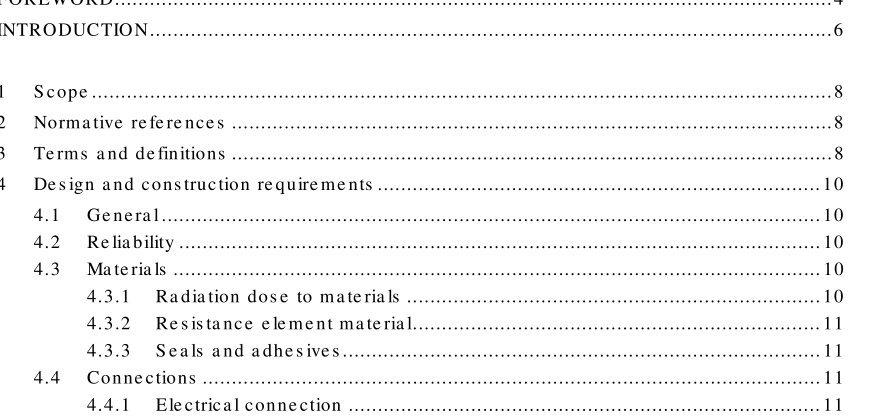IEC 62397-2007 pdf Nuclear power plants – Instrumentation and control important to safety – Resistance temperature detectors

4.3.2 Resistance element material Platinum is used extensively for resistance thermometers in an NPP for both safety- and non- safety-related instrument applications. Platinum is a noble metal, relatively stable and unaffected by its surrounding environment. It resists corrosion, oxidation, and other forms of chemical attack. It is easily workable and can be drawn into fine wires. Platinum has a high melting- point, which shows little volatilization below 1 000 °C. Platinum can be obtained to a high degree of purity, which has a reproducible electrical and chemical characteristic over a wide range of temperatures. All this is evidenced by a simple linear and stable resistance temperature relationship that characterizes the platinum sensor. However, the electrical resistance of platinum wire is extremely sensitive to minute quantities of contaminating impurities and to strains; both of these characteristics may alter the simple resistance- temperature relationship. Other metals may also be used for resistance thermometers provided their accuracy, repeatability, response time, and reliability comply with the requirements of the applications. The sensing wire shall be mounted so as to be almost free of strains to avoid the strain gauge effect from causing extraneous changes in resistance. Furthermore, the thermometer shall be manufactured with the resistance element free of contaminants. 4.3.3 Seals and adhesives The RTD shall be hermetically sealed. The connector may or may not be an integral part of the RTD assembly. RTD used in a harsh environment, such as under high-temperature and/or radiation areas, shall be designed without organic material. The use of ceramic material is recommended. The tightness of the insulating termination shall be tested according to an adequate and proven procedure. Commonly suggested seals of the connector are glass-to-metal or ceramic-to-metal, which should have less than 10 –8 cm 3 /s leak rate when tested with helium at an atmospheric differential pressure.
- ISO IEC 27050-4-2021 pdf Information technology — Electronic discovery — Part 4: Technical readiness
- ISO IEC 27036-1-2021 pdf Cybersecurity — Supplier relationships — Part 1: Overview and concepts
- ISO IEC 27013-2021 pdf Information security, cybersecurity and privacy protection — Guidance on the integrated implementation of ISO/IEC 27001 and ISO/IEC 20000-1
- ISO IEC 26580-2021 pdf Software and systems engineering — Methods and tools for the feature- based approach to software and systems product line engineering
- ISO IEC 24735-2021 pdf Information technology — Office equipment — Method for measuring digital copying productivity
- ISO IEC 24711-2021 pdf Information technology — Office equipment — Method for the determination of ink cartridge yield for colour inkjet printers and multi- function devices that contain printer components
- ISO IEC 23544-2021 pdf Information Technology — Data centres — Application Platform Energy Effectiveness (APEE)
- ISO IEC 23510-2021 pdf Information technology — 3D printing and scanning — Framework for an Additive Manufacturing Service Platform (AMSP)
- ISO IEC 23127-1-2021 pdf Information technology — Learning, education, and training — Metadata for facilitators of online learning — Part 1: Framework
- ISO IEC 23126-2021 pdf Information technology for learning, education and training — Ubiquitous learning resource organization and description framework
- IEC 62973-4-2021 pdf Railway applications – Rolling stock – Batteries for auxiliary power supply systems – Part 4: Secondary sealed nickel-metal hydride batteries
- IEC 61138-2007 pdf Cables for portable earthing and short-circuiting equipment
- IEC 62372-2021 pdf Nuclear instrumentation – Housed scintillators – Test methods of light output and intrinsic resolution
- ISO IEC 18328-2-2021 pdf Identification cards — ICC-managed devices — Part 2: Physical characteristics and test methods for cards with devices
- IEC 62282-7-2-2021 pdf Fuel cell technologies – Part 7-2: Test methods – Single cell and stack performance tests for solid oxide fuel cells (SOFCs)
- BS ISO IEC 15420-2009 pdf Information technology一 Automatic identification and data capture techniques EAN/UPC bar code symbology specification
- BS ISO IEC 19762.5-2008 pdf Information technology一 Automatic identification and data capture (AIDC) techniques – Harmonized vocabulary Part 5: Locating systems
- BS IEC 60860-2014 pdf Radiation protection instrumentation一 Warning equipment for criticality accidents
- ISO IEC 24735-2021 pdf Information technology — Office equipment — Method for measuring digital copying productivity
- ISO IEC 24711-2021 pdf Information technology — Office equipment — Method for the determination of ink cartridge yield for colour inkjet printers and multi- function devices that contain printer components